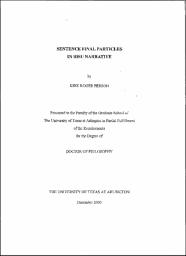
ATTENTION: The works hosted here are being migrated to a new repository that will consolidate resources, improve discoverability, and better show UTA's research impact on the global community. We will update authors as the migration progresses. Please see MavMatrix for more information.
Show simple item record
| dc.contributor.author | Person, Kirk Roger | |
| dc.date.accessioned | 2020-10-09T15:21:18Z | |
| dc.date.available | 2020-10-09T15:21:18Z | |
| dc.date.issued | 2000-12 | |
| dc.identifier.uri | http://hdl.handle.net/10106/29486 | |
| dc.description.abstract | Particles are a vital component of many Asian languages. Nonetheless, they typically receive little treatment in grammatical studies. This may be due in part to the theoretical orientations of generative grammar which, intentionally or accidentally, can tend to skew data collection and analysis toward theory-predicted sentence alignments (Chu 1998, Chan 1999). In addition, the exact meaning and usage of many particles can be anything but obvious. Even educated native speakers often claim that particles are not “true words” and have no “real” meaning. This dissertation seeks to understand the inner workings of sentence final particles in the Bisu language of Northern Thailand. Thirteen written folktales, six expository texts, and three life histories are examined in an effort to determine the factors influencing particle usage. Variables including place in the discourse, relative transitivity, sentence complexity, occurrence (or nonoccurrence) in quotations, and evidential perspective are addressed in the context of individual particles and their host sentences. This dissertation draws from the general framework of discourse analysis espoused by Robert E. Longacre (1996). Paul J. Hopper and Sandra A. Thompson's “transitivity hypothesis” (1980) is applied in an effort to quantitatively represent the different types of sentences in which the various particles occur. James A. Matisoff's work on Lahu grammar (1973) is used in conjunction with the author's research and the intuitions of Bisu native speakers in an effort to “triangulate” the semantic connotations of many particles. The results of this investigation demonstrate the primacy of text type in Bisu particle usage: those particles that see abundant use in the folktales occur rarely in the expository text and the life stories. In addition, the point in the discourse at which a sentence is used influences particle distribution; certain particles are never used in the opening and closing portions of a story, while sentences in pre-peak episodes typically take many more particles than their counterparts in other points in the discourse. These findings highlight the importance of taking discourse features into account when constructing grammars of languages in Asia and elsewhere. | en_US |
| dc.language.iso | en_US | en_US |
| dc.publisher | University of Texas at Arlington | en_US |
| dc.subject | Language | |
| dc.subject | Literature and linguistics | |
| dc.subject | Bisu | |
| dc.subject | Discourse analysis | |
| dc.subject | Final particles | |
| dc.subject | Narrative | |
| dc.subject | Thailand | |
| dc.title | SENTENCE FINAL PARTICLES IN BISU NARRATIVE | en_US |
| dc.type | Dissertation | en_US |
| thesis.degree.department | Humanities | |
| thesis.degree.name | Doctor of Philosophy in Humanities | |
Files in this item
- Name:
- Sentence Final Particles in Bisu ...
- Size:
- 12.24Mb
- Format:
- PDF
- Description:
- PDF
This item appears in the following Collection(s)
Show simple item record


